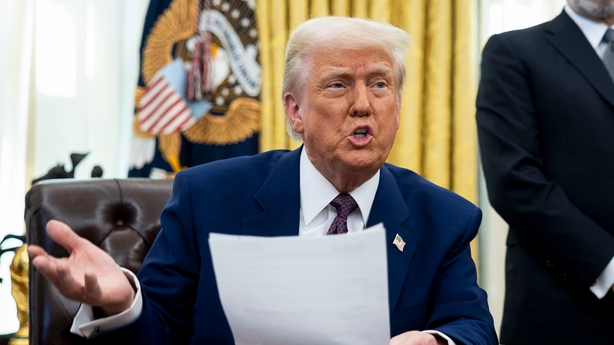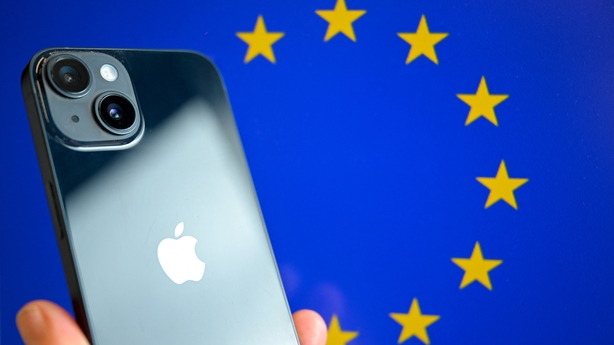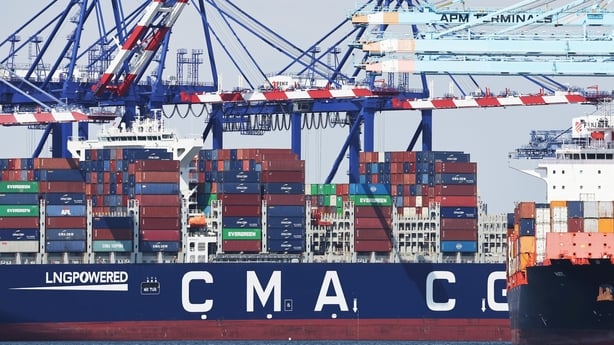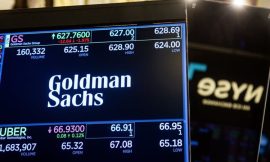How worried should Ireland – and the rest of the EU – be about the “fair and reciprocal plan” for tariffs announced by US President Donald Trump?
On the surface, the president lashed out at a lot of Irish connected things – the pharmaceutical industry, Apple, the EU courts, airline charges, agriculture products.
Not to mention VAT in the EU, and the Digital Services Tax levied by France. Remember all those tech leaders on the much restricted platform sitting behind Mr Trump when he was being sworn in as president a few short weeks ago: three of the top five taxpayers in Ireland were there.
The tariffs may be the least of it. Just as we saw in the Brexit negotiations, there are things called “non-tariff barriers” to trade (NTBs) – better known as rules and regulations.
And the order signed yesterday contains a big attack on VAT – one of the key revenue raising tools for all European governments (and many others beyond Europe – but not the US).
And the concept of a Digital Services Tax (France and Canada were singled out for special mention). That was about the only recognition of the trade in services – which are not subject to tariffs, and in which the US enjoys a huge surplus in its dealings with Europe. But Mr Trump never mentions the trade in services, only goods.

Asked by a friendly reporter about the EU’s Value Added Tax , Mr Trump said it was equivalent to an extra tariff.
“They have a 20% VAT tax, which we’re considering to be similar, the same as the tariff, plus they charge lots of fees, and, you know, they’re doing something else. European Union’s been very tough on our companies.
“They sued Apple, they sued Google, they sued Facebook, they sued many other companies – and they’re American companies – and the kind of numbers are staggering, and the court system over there is not very good to our companies.”
“If you know that Apple had to pay, I think, $16 billion in a penalty, a court case, that was really shocking, because most people thought they would have won that court case, the people that watched it so they’ve been very tough.
“Airlines have called me up and they said, could you help us with Europe? Because they’re charging us so many different fees. I got a call from the head of American United and other airlines saying, every time we land the plane, we get just absolutely killed by the European Union. And so they haven’t been treated as good.
“You know, we think European Union is wonderful. We all love Europe. Love the countries in Europe, but European Union has been absolutely brutal on trade,” he said.
But there is no detail, no actual plan here. Instead there is a memo setting out some actions to be taken by cabinet level chiefs to help fill in the considerable blanks in a bare bones policy direction which is taking shape.
The first of them is a review by the Commerce Department to find out the tariff imbalances. Its new cabinet Secretary Howard Luttnick says that should be ready by 1 April. Mr Trump can then decide what action to take.

The memo sets out the policy aims of this concentration on tariffs VAT and all the rest: “The ‘Fair and Reciprocal Plan’ will seek to correct longstanding imbalances in international trade and ensure fairness across the board. Gone are the days of America being taken advantage of: this plan will put the American worker first, improve our competitiveness in every area of industry, reduce our trade deficit, and bolster our economic and national security.
“AMERICA WILL NO LONGER TOLERATE UNFAIR TRADE PRACTICES: The United States is one of the most open economies in the world, yet our trading partners keep their markets closed to our exports.”
It says in two thirds of the 600,000 tariff lines investigated in 123 countries, the US is disadvantaged in two thirds of them.
It then says there are endless examples of unfair trade, but for the EU cites just two: the EU tariffs on cars (which is changing now) and a ban on shellfish exports from 48 states (though only 24 are coastal and produce shellfish) due to delays in issuing approvals for exports as promised in 2020 (but then there was a pandemic, and lots of things got delayed).
The memo claims the US has one of the most open economies in the world, and has among the lowest average weighted tariff rates in the world (the EU says the same about itself).
The memo says the US has been treated unfairly by trade partners “both friend and foe”, and this has resulted in large and persistent annual trade deficits.
It says this trade deficit “threatens our economic and national security, has hollowed out our industrial base, has reduced our overall national competitiveness, and has made our nation dependent on other nations to meet our key security needs”.
To remedy this, the memo states it is now the policy of the US to reduce this imbalance in goods trade and address “other unfair and unbalanced aspects of our trade with foreign partners”. Again, no mention of the very large US surplus in the trade in services.
That is an important distinction when considering the list of targets for addressing the trade imbalance: not just tariffs on goods imported from the US, but also – “unfair, discriminatory or extraterritorial taxes…including value added tax”.
It also gives authority to a committee of the US Trade Representative, the Treasury Secretary, the Commerce Secretary and Senior Counsellor to the President for Trade and Manufacturing (Peter Navarro) to identify “any unfair limitation on market access or any structural impediment to fair competition with the market economy of the United States”. Which is a pretty wide brief.
In an interview with CNN shortly after the signing, Mr Navarro offered an example from the EU. “The European Union has a 10% tariff on autos, and we have a 2.5%, so that’s four times higher. But in addition to that they have a Value Added Tax that works as a 19% tariff on our autos, and also as a huge export subsidy.
“And so what you observe is Germany sells us eight times more cars than we sell them. We run a more than $200 billion deficit with them, and it’s all driven by this unfair trade. The president says he’s going to calculate equivalent, reciprocal tariffs to stop that, unless these foreign countries reduce their trade barriers.
“It’s a proverbial win-win for America, because we’ll get our production back, and we’ll get our factories back. We’ll get more jobs, right? Get higher wages. That’s the plan.”
The focus on VAT is rather strange. Firstly, it’s a sales tax and applies to all sales of goods and services in the EU (and the UK, for that matter). It is not a tariff or a punishment on imports: regardless of where a good is made, if it’s sold in the EU, VAT is charged.
US cars don’t sell in Europe because they are too expensive due to VAT – EU-made cars also face VAT (and VRT if sold in Ireland). They don’t sell because they use massive engines that are uneconomic in a continent where petrol costs more than twice as much as it does in the US.
Secondly, VAT – or its equivalent, a consumption tax – is one of the measures proposed as part of a major tax reform for the United States in “Project 2025”, the conservative think tank The Heritage Foundation’s plan for the second Trump administration says.
It says: “The public finance literature is clear that a consumption tax would minimise government’s distortion of private economic decisions and thus be the least economically harmful way to raise federal tax revenues.
“There are several forms that a consumption tax could take, including a national sales tax, a business transfer tax, a Hall–Rabushka flat tax, or a cash flow tax.” (the presidential memo defines VAT as “a type of consumption tax”).

One of the key authors of Project 2025, Russel Vought, is now the Trump administration’s Director of the Office of Management and Budget (OMB), and is listed on the memo on foreign trade distortions signed by the President.
He is assigned the job of assessing the fiscal impacts of proposed trade remedies on the US government and people within 180 days of the measures being proposed. So on the current timetable, that looks like an October deadline for finding out the bad domestic effects of this new trade policy.
Which should give the EU time to plan its own response. It’s been working on a range of actions, using Project 2025 for guidance, no doubt – and guided by its previous reaction to Trump tariffs last time (the imposed measures from the first Trump administration are “frozen” – and can be “unfrozen” for immediate application, according to a senior EU source).
But mostly the EU is laying low, waiting to see what actually transpires. The move on car tariffs may help. The offer, made immediately after Trump won the election to replace Russian oil and gas contracts with US contracts can go some way to closing the trade gap in goods (Indian Prime Minster Narendra Modi made a similar offer when he met Mr Trump just after he signed the tariffs memo yesterday).
And the rise in European Defence spending will also go a long way in closing the overall trade gap – though the future taxation of the digital economy is likely to remain a point of friction.
Avoiding disruption and a potentially damaging trade war will be the goal of the EU and its member states.
But that doesn’t mean it won’t be rough if it has to be: after all, an attack on VAT is an attack on the fundamental tax sovereignty and revenue raising capacity of every state in the EU. How much of the attack on VAT is a feint, looking for a deal on something else (digital services?) and how much is real has to be teased out when the details emerge.
The way the Americans tell it, they are a naive totally open market that every foreigner on the planet (yeah Ireland, looking at you too) is taking advantage of. The EU, Donald Trump says, has been “brutal” on trade with America.
The way the trade Eurocrats in Brussels tell it, the Americans have loads of trade barriers to protect their own industries and have been quite ruthless about it – and have been carrying vast amounts of loot out of Europe over the past 70 years.
So the ruthless and the brutal may be about to square off in another confrontation over their joint market, which accounts for 40% of global trade – and one with a very low overall tariff rate between the two big markets.
Or maybe not. Depends on what the Luttnick review finds out, what the real deal is about, and what the EU will offer as a sweetener – whilst remaining brutal on the overall principles of international trade and taxation.




